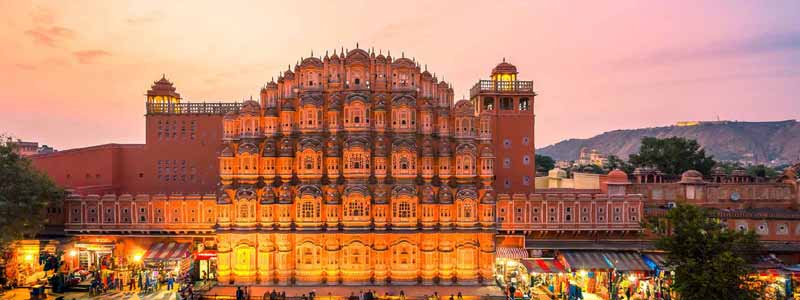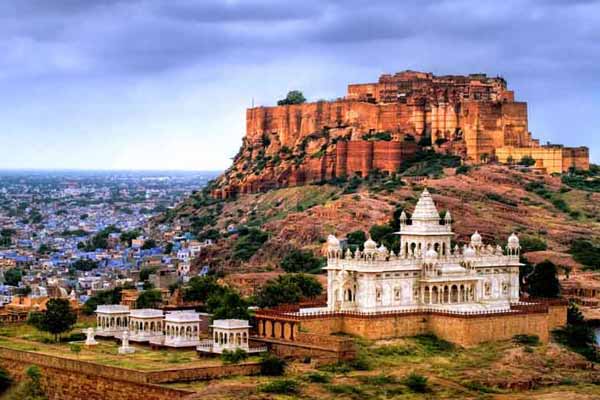6 Best Places to Visit in Rajasthan in February If you haven’t seen Rajasthan then February is the best time to explore and make sure that you spend at least few days so that you can get to know the history and can also get to know a lot of other things like key experiences, detectable food, exclusive handicrafts and a peek into the local lifestyle of the people. We have listed several places to visit in Rajasthan in February in the best way possible.

Jaipur
Popularly known as ‘Pink City’, Jaipur is one of the best destinations that you can explore in February. Founded by Maharaja Sawai Jai Singh back in 1727, Jaipur depicts the historic and heritage monuments. The place attracts a lot of people around the year and in February, the weather is almost pleasant. You can witness a lot of monuments and other things to know more about the destination. Jaipur is a marvel to be if you are planning to visit here anytime soon!
- Resorts: Madhav Guest House, Hathroi Palace, Ikaki Niwas, Rawla Rawatstar, Jaipur Friendly Villa, Rajputana Guest House
- Nearest airport: Sanganer airport-12.0 km
- Nearest railway station: Jaipur Junction railway station-4.9 km
- Best time to visit: All through the year, avoid summers for the days are extremely hot.
- Major attractions in Jaipur: City Palace, Amber Fort and Palace, Jantar Mantar Observatory, Birla Mandir.
- Things to do in Jaipur: Go for a wildlife safari, shop for Rajasthani crafts, textiles, and gems
- Popular for: Havelis, forts, shopping markets

Jaisalmer
Also known as ‘The Golden City’ of Rajasthan, Jaisalmer is one of the most sought-after destinations that you can visit in February and enjoy to the fullest. Nestled in the heart of Thar Desert, this destination is sun-soaked sand dunes, pristine forts and filled with rich culture and traditions. Apart from this, Jaisalmer also offers forts, palaces and several temples. The city got its name after Maharaja Jaisal Singh 6 Best Places to Visit in Rajasthan in February.
- Resorts: Fort Rajwada Jaisalmer, Suryagarh Jaisalmer Rajasthan, Hotel Jaisalkot, Sujan, Jaisalmer Marriott Resort & Spa, Hotel Rang Mahal
- Nearest airport: Jodhpur Airport-284.6 km
- Nearest railway station: Jaisalmer railway station-2.8 km
- Best time to visit: September to April
- Places to visit in Jaisalmer: Jaisalmer Fort, Sam sand dunes, Gadisagar Lake, Tanot Mata Temple
- Things to do in Jaisalmer: Attend the Desert festival of Jaisalmer in January – February, take a camel safari to the Sam sand dunes, visit Longewala border
- Popular for: Desert festivals, Jain temples
- Best Tour Plan: 3 Nights 4 Days Jaisalmer Tour Package
Jodhpur
Well, Jodhpur is just an extension of the royalty that you get to see at Jaisalmer and Jaipur. The royal city once was the centre of power of the Mewar state. They constructed several forts, palaces and temples that reflect the culture and architecture of that time. Also known as ‘Blue City’, Jodhpur is a true essence of history and houses near the Mehrangarh Fort that is a spectacle of magnificence 6 Best Places to Visit in Rajasthan in February.
- Resorts: Mihir Garh, Taj Umaid Bhawan Palace , Rohetgarh, Hari Mahal, Indana Palace, Park Plaza
- Nearest airport: Jodhpur Airport-9.6 km
- Nearest railway station: Jodhpur Junction-9.2 km
- Best time to visit: All through the year
- Places To Visit In Jodhpur: Mehrangarh Fort, the Umaid Bhawan Palace, the Mandore Gardens, the Jaswant Thada, the Kalyana Lake, and Garden, the Ghanta Ghar, Sardar Samand Lake and Masuria Hills
- Things to do in Jodhpur: Visit the palaces; Mehrangarh fort can’t be missed
- Popular for: Palaces, forts
- Best Tour Plan: 8 Nights 9 Days Royal Rajasthan Tour
Udaipur
Yet another best place to visit in Rajasthan in February is Udaipur. This destination reflects the rich culture plus royalty on the other hand. It used to be the capital of the kingdom of Mewar. Known as the City of Lakes, it is a beautiful place to visit in Rajasthan. It offers tons of tourist places like Lake Palace, City Palace, Jagdish temple and many more, Udaipur is also known as the Venice of East 6 Best Places to Visit in Rajasthan in February.
- Resorts: Little Prince Heritage Home, Hill Top Cottage, Advent Guest House, Udai Haveli Guest House, Nandini Paying Guest House
- Nearest airport: Maharana Pratap Airport-20.0 km
- Nearest railway station: Udaipur railway station-4.3 km
- Best time to visit: Monsoon (July to September) and Winter (November to February)
- Major attractions in Udaipur: Lake Pichola, Fateh Sagar Lake, City Palace, Jag Mandir, Udai Sagar Lake, Jagdish Temple, Monsoon Palace, Swaroop Sagar, Kumbhalgarh Fort
- Things to do in Udaipur: Boating at Lake Pichola, visiting the palaces, visiting Kumbhalgarh fort, photography.
- Popular for: Lakes, palaces
- Best Tour Plan: 3 Nights 4 Days Udaipur Tour Package
Mount Abu
Mount Abu takes pride in being the only hill station in Rajasthan. It is said to be one of the most amazing tourist attractions in Rajasthan in February. A true traveler’s paradise in every sense, Mount Abu lies in the Aravalli Mountain range at the border of Rajasthan and Gujarat. Other than providing an escape from the scorching heat of 6 Best Places to Visit in Rajasthan in February owing to its natural splendor and year-round pleasant weather, Mount Abu is considered a great spot for pilgrimage.
- Resorts: Palace Hotel, Cama Rajput Club Resort, Ratan Villas, The Colonial Manek Manor, Hotel Hilltone
- Nearest airport: Udaipur airport-176.0 km
- Nearest railway station: Abu Road railway station-(27.3 km
- Best time to visit Mount Abu: Throughout the year
- Places to visit in Mount Abu: Dilwara Jain Temples, Nakki Lake, Peace Park, Mount Abu Wildlife Sanctuary, and more
- Things to do in Mount Abu: Boating in Nakki Lake, trekking to Guru Shikhar, camping at Aravali, bird watching at Trevors Tank, wildlife sighting at Mount Abu Wildlife Sanctuary
- Popular for: Waterfalls, Jain temples
Pushkar
Pushkar is known as the best tourist place in Rajasthan during February. This is a riot of colors in the true sense. The holy city has been known all over the world for its annual Camel Fair. One of the most ancient cities of India, Pushkar houses the rare Brahma Temple. Besides, the Pushkar Lake is also popular Hindu pilgrimage for the people of India and you would see them turning up here every year. If you are a photographer enthusiast then you can also visit Pushkar 6 Best Places to Visit in Rajasthan in February.
- Resorts: Hotel Brahma Horizon, Pushkar Bagh, Bhanwar Singh Palace, Hotel Sun Set Cafe, Hotel Master Paradise
- Nearest airport: Sanganer Airport-154.3 km
- Nearest railway station: Ajmer junction-14.0 km
- Best time to visit: October-November for the world-famous Pushkar Camel Fair
- Major attractions in Pushkar: The world famous camel fair, the serene Pushkar lake, and Meerabai Temple
- Things to do in Pushkar: Boating in the lake, photography at the fair
- Popular for: Camel fair
- Best Tour Plan: 3 Nights 4 Days Jaipur Ajmer Pushkar Tour
